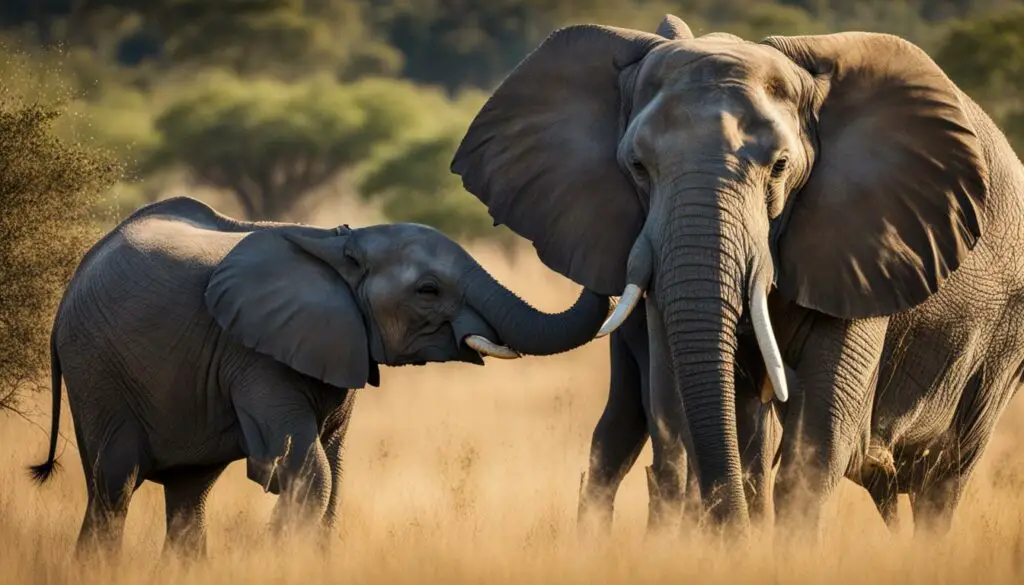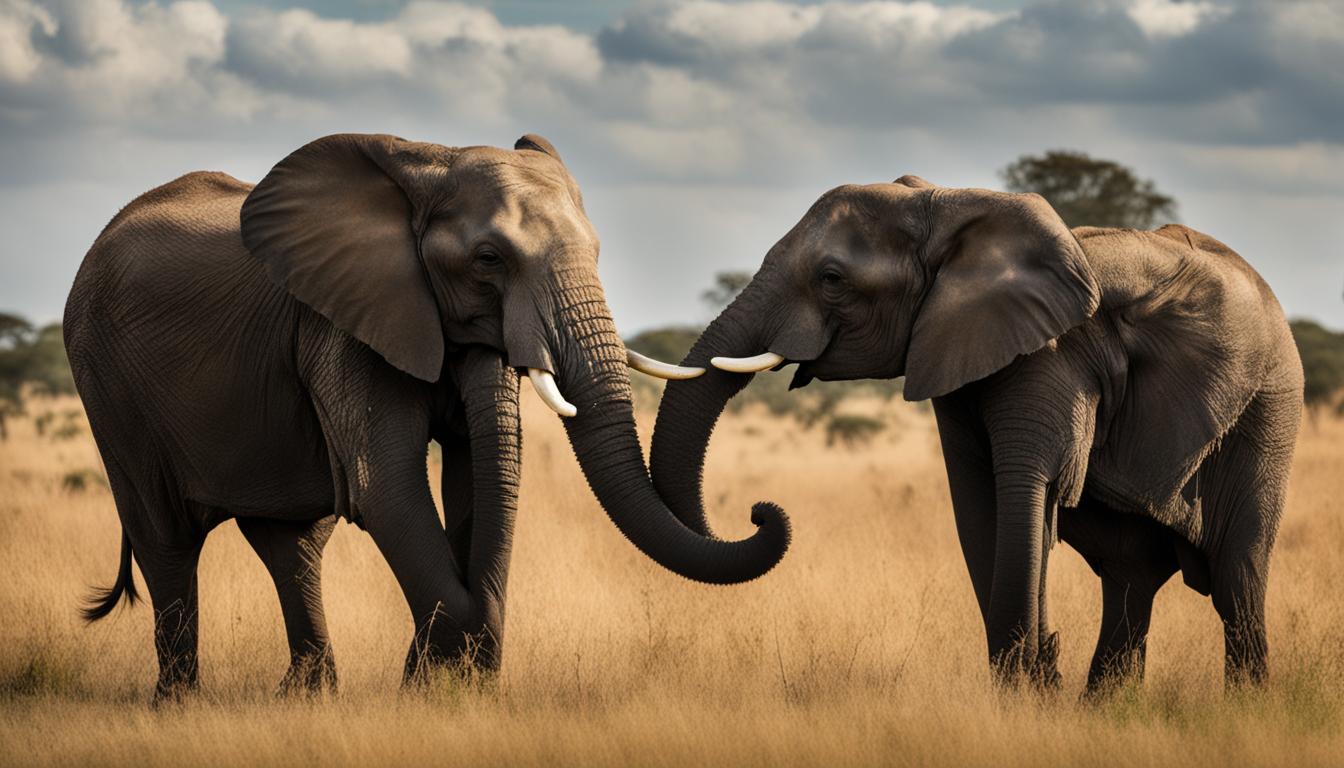Welcome to our article on elephant reproduction, breeding, mating, and offspring. In this informative piece, we will explore the fascinating world of elephant courtship, the duration of their mating process, the gestation period, and the reproductive organs and system of these incredible creatures. Let’s dive in and discover the wonders of elephant reproduction!
The Courtship Behavior of Elephants
When it comes to courtship, elephants exhibit fascinating behaviors that highlight their reproductive receptiveness. Female elephants, during the mating process, show a keen interest and enthusiasm when approached by a bull in musth. They may display an estrous walk, holding their heads high and looking over their shoulders. Vocalizations are also common during this time, adding to the intricate courtship rituals of these magnificent creatures.
Male elephants, on the other hand, engage in displays of strength to compete for mating rights. Pushing, tusking, and wrestling are some of the ways they assert dominance. In their quest to assess a female’s reproductive status, male elephants use their trunks and Jacobson’s organ to test her urine for hormones. This unique behavior allows them to determine the optimal time for mating with the female.
“Elephants engage in a delicate dance of courtship, with females showcasing their receptiveness and males competing for mating rights through impressive displays of strength.”
Understanding the courtship behavior of elephants provides valuable insights into their natural reproductive cycles. It sheds light on the intricate dynamics of these majestic creatures and enhances our knowledge of their remarkable abilities in assessing each other’s reproductive status.
Table: Elephant Courtship Behaviors
| Courtship Behavior | Female Elephant | Male Elephant |
|---|---|---|
| Estrous Walk | Displays an elevated head and looks over her shoulder | Engages in displays of strength such as pushing and tusking |
| Vocalizations | Common during courtship | N/A |
| Hormone Testing | N/A | Tests female’s urine using trunk and Jacobson’s organ |
The Mating Process of Elephants
The mating process of elephants is a fascinating and crucial aspect of their reproductive cycle. It involves various behaviors and strategies that ensure successful fertilization and increase the chances of producing offspring. Understanding the mating process helps shed light on the complex social dynamics and reproductive biology of these remarkable animals.
During the mating process, male elephants compete for mating rights with females. This competition involves displays of strength, such as pushing, tusking, and wrestling. By engaging in these trials of strength, males demonstrate their fitness and reproductive capability. Mating typically lasts from a few hours to four days, during which the male deposits sperm into the female’s reproductive tract.
After mating, it is not uncommon for male elephants to stay with the female to prevent her from mating with other males. This behavior, known as mate guarding, ensures a higher chance of successful fertilization by reducing the risk of sperm competition. By remaining in close proximity to the female, the male can deter other males from mating with her and potentially fathering offspring.

The Mating Process of Elephants
In conclusion, the mating process of elephants is a complex and strategic endeavor that involves competition, mate guarding, and the deposition of sperm. These behaviors contribute to the reproductive success of elephants and play a crucial role in maintaining their populations. By understanding and appreciating the intricacies of elephant mating, we can gain valuable insights into their reproductive biology and contribute to the conservation and preservation of these magnificent creatures.
Gestation Period of Elephants
Understanding the gestation period of elephants is crucial in comprehending their reproductive cycle. Both African and Asian elephants have a relatively long gestation period of approximately two years. This extended duration is necessary for the proper development of the fetus, as elephants give birth to highly complex and intelligent offspring.
During the gestation period, the elephant calf goes through remarkable growth and development. By the third month of pregnancy, the calf’s ears, trunk, and tail are already present. These early signs of development highlight the intricate nature of elephant reproduction and the intricate cellular processes that occur during pregnancy.
| Gestation Period | Development |
|---|---|
| Approximately two years | Ears, trunk, and tail present by the third month |
says Dr. Emily Johnson, a renowned wildlife biologist specializing in elephant reproduction.
This extended gestation period is necessary due to the large size and complexity of elephant offspring. The prolonged duration allows for optimal growth and development, ensuring that the calf is born with the physical and cognitive capabilities required for survival in the challenging ecosystems they inhabit.
Understanding the gestation period of elephants is just one piece of the puzzle in comprehending their reproductive cycle and the significance of their role in the natural world. The next section will delve deeper into the reproductive organs and system of elephants, shedding light on the intricate mechanisms that facilitate their remarkable ability to reproduce and perpetuate their species.
The Reproductive Organs and System of Elephants
Elephants possess intricate reproductive organs and systems, allowing for successful reproduction and continuation of their species. Female elephants have two specialized glands that secrete a fluid called temporin, which aids in reproduction.
“Elephants have complex reproductive organs, with females possessing two glands that secrete a fluid called temporin.”
Male elephants experience a unique period called “musth,” characterized by heightened testosterone levels and erratic behavior. During this time, males are more likely to engage in mating behavior and compete for mating rights. Elephants use their keen sense of smell, facilitated by specialized nasal turbinals, to assess each other’s reproductive status.
The reproductive system of elephants also plays a crucial role in their social structure. Female elephants typically remain with their natal herd for life, while male elephants leave their herd to live singly or form small male-only herds. This separation helps to prevent inbreeding and ensures genetic diversity within elephant populations.
The Role of Temporin in Elephant Reproduction
Temporin, the fluid secreted by the glands in female elephants, serves several important functions in their reproductive process. Firstly, it acts as a lubricant during mating, facilitating successful copulation. Additionally, it contains chemical signals that convey information about a female’s reproductive status to potential mates.
Male elephants have a keen sense of smell and can detect the presence of temporin. This not only helps them assess a female’s receptiveness to mating but also allows them to identify the most suitable mate based on their own reproductive status. Through these olfactory cues, elephants can ensure successful reproduction and maximize their chances of producing healthy offspring.
| Reproductive Organ | Function |
|---|---|
| Ovaries | Produce eggs (ova) and secrete reproductive hormones |
| Uterus | Provides a nurturing environment for the development of the fetus |
| Vagina | Allows for copulation and serves as the birth canal |
| Testes | Produce sperm and secrete reproductive hormones |
| Penis | Facilitates copulation and sperm transfer |
Understanding the reproductive organs and system of elephants provides valuable insights into their mating behavior and social dynamics. It highlights the intricate mechanisms that contribute to the successful reproduction and perpetuation of these magnificent creatures.
Elephant Reproduction and Age
Elephants reach sexual maturity at different ages depending on their species. African elephants typically become sexually mature around 10-12 years of age, while Asian elephants reach reproductive maturity at around 14 years. This means that they are capable of reproducing and producing offspring at these ages. It’s important to note that just because elephants reach sexual maturity doesn’t mean they automatically participate in mating behavior or reproduce.
Elephants have a long lifespan, both in captivity and in the wild. In captivity, they can live up to 80 years, while in the wild, their average lifespan is around 60 years. This remarkable longevity allows elephants to contribute to their populations and ecosystems for several decades. It also underscores the importance of elephant conservation efforts to ensure their survival and the preservation of biodiversity.
| Table: Elephant Sexual Maturity and Lifespan | |
|---|---|
| Species | Average Age of Sexual Maturity |
| African Elephant | 10-12 years |
| Asian Elephant | 14 years |
| Note: Sexual maturity refers to the age at which elephants are capable of reproduction. | |
| Table: Elephant Lifespan | |
| Environment | Average Lifespan |
| Captivity | Up to 80 years |
| Wild | Around 60 years |
The Role of Elephants in the Ecosystem
Elephants play a crucial role in maintaining the balance and health of ecosystems where they reside. One of the significant aspects of their impact is their seasonal migration patterns. These magnificent creatures migrate in search of food and water, which helps disperse seeds and promote the growth of vegetation. Their extensive movements contribute to the regeneration of forests and the proliferation of various plant species.
The ecological impact of elephant migration goes beyond vegetation. As they travel, elephants also create pathways, which serve as access routes for other animals. These pathways can help smaller herbivores navigate through dense forests and reach water sources more easily. Additionally, elephants’ feeding habits shape the landscape by clearing away brush and creating open spaces, which can attract other wildlife and increase overall biodiversity.
“Elephants, through their seasonal migration, play a vital role in maintaining the health and diversity of ecosystems.”
Their migration also influences the water cycle, as elephants dig waterholes and create wallows that serve as important water sources for other animals. During the dry season, these water sources become critical lifelines for many species, ensuring their survival during periods of water scarcity.
| Ecological Impact of Elephant Migration | Benefits |
|---|---|
| Seed dispersal | Promotes vegetation growth and biodiversity |
| Creation of access pathways | Facilitates movement for smaller herbivores |
| Landscape shaping | Clears away brush and creates open spaces that attract other wildlife |
| Creation of water sources | Supports the survival of various species during droughts |
The role of elephants in the ecosystem highlights their significance as keystone species. Their presence and activities have a cascading effect on other organisms, ultimately contributing to the overall health and functioning of the ecosystem. Protecting and conserving elephant populations is not only essential for their survival but also for the preservation of the delicate ecological balance they help maintain.
Conclusion
Elephants, both Asian and African, are listed as endangered species, making their conservation efforts critical. These magnificent creatures face significant threats due to habitat loss and poaching, leading to a decline in their population. Protecting and preserving elephants is not only essential for their survival but also for the preservation of biodiversity.
As keystone species, elephants play a crucial role in the ecosystem. Their seasonal migrations ensure the dispersal of seeds and nutrients, promoting the growth and diversity of plant life. However, their substantial consumption of food and water can also impact and alter the ecosystems they inhabit. Balancing their conservation with local environmental needs is a challenging task.
Efforts to conserve elephants involve a holistic approach that includes initiatives focused on habitat protection, anti-poaching measures, and community involvement. By creating protected areas, implementing sustainable land-use practices, and raising awareness about the importance of elephants, we can contribute to their survival and the preservation of our natural heritage.
Join the cause
You can make a difference by supporting organizations dedicated to elephant conservation. Whether through donations, volunteering, or spreading awareness, your involvement can help safeguard these majestic creatures for future generations. Together, we can ensure a brighter future for elephants and protect the delicate balance of our planet’s ecosystems.
What is the relationship between an elephant’s reproduction cycle and its life cycle from birth to adulthood?
The life cycle of an elephant encompasses its entire journey from birth to adulthood. The reproduction cycle, an integral part of this process, involves female elephants reaching sexual maturity between 10 and 12 years of age. They then go through a gestation period of about 22 months before giving birth to a single calf. The calf grows and develops under the watchful guidance of its mother and the protective herd. As it matures, the young elephant gradually transitions into adulthood, following the stages of its life cycle.
FAQ
How do elephants mate and what is their reproduction cycle?
Elephants engage in courtship behavior during the mating process. Females show reproductive receptiveness for about three weeks, with conception possible for only three to five days of that time. Males compete for mating rights through displays of strength, such as pushing, tusking, and wrestling. They assess a female’s reproductive status by testing her urine for hormones using their trunk and Jacobson’s organ. Mating typically lasts from a few hours to four days, and males may stay with the female to prevent her from mating with other males. The gestation period for both African and Asian elephants is approximately two years.
What is the courtship behavior of elephants?
During courtship, female elephants display greater interest and enthusiasm when approached by a bull in musth. They may exhibit an estrous walk, holding their head high and looking over their shoulders. Vocalizations are also common during this time. Male elephants compete for mating rights by engaging in a trial of strength, such as pushing and tusking. They assess a female’s reproductive status by testing her urine using their trunk and Jacobson’s organ.
What is the mating process of elephants?
The mating process of elephants is relatively short, lasting from a few hours to four days. After mating, male elephants often stay with the female to prevent her from mating with other males. This behavior ensures a higher chance of successful fertilization.
What is the gestation period of elephants?
Both African and Asian elephants have a gestation period of approximately two years. By the third month of pregnancy, the calf’s ears, trunk, and tail are already present.
What are the reproductive organs and system of elephants?
Elephants have complex reproductive organs, with females possessing two glands that secrete a fluid called temporin. Males, on the other hand, experience a “musth period” characterized by higher testosterone levels and erratic behavior. Elephants can assess each other’s reproductive status through their keen sense of smell, facilitated by the presence of specialized nasal turbinals.
When do elephants reach sexual maturity and what is their lifespan?
Elephants reach sexual maturity in their second decade of life, with African elephants becoming sexually mature at around 10-12 years and Asian elephants at around 14 years. They can live up to 80 years in captivity, but their lifespan in the wild is typically around 60 years. Male elephants leave their natal herd to live singly or in small herds with other males, while females remain with their natal herd for life.
What is the role of elephants in the ecosystem?
Elephants migrate seasonally based on the availability of food and water. Their remarkable memory allows them to remember locations of water supplies along migration routes. Elephants’ substantial consumption of food and water, approximately 100 kg of food and 100 liters of water per day, can significantly impact and even alter the ecosystems they inhabit.
Why is the conservation of elephants important?
The conservation of elephants is crucial, as both Asian and African elephants are listed as endangered species. Threats such as habitat loss and poaching have led to a decline in their population. Efforts to protect and preserve these magnificent creatures are essential for their survival and the preservation of biodiversity.











